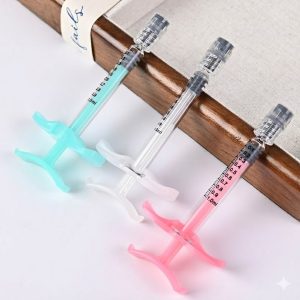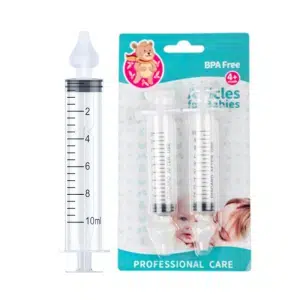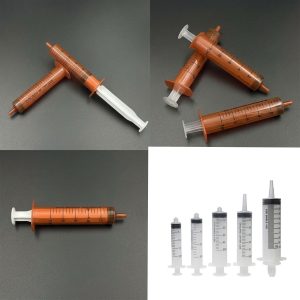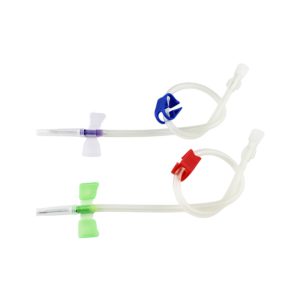Oral syringes have become an indispensable tool in modern home healthcare, offering precision and safety that traditional measuring methods simply cannot match. According to clinical studies, approximately 43% of medication errors stem from inaccurate dosing, while proper use of calibrated oral syringes can reduce this error rate to below 5%. This comprehensive guide provides evidence-based protocols for the safe and effective use of disposable oral syringes in home settings.
1. Understanding Oral Syringes: Technical Specifications & Standards
1.1 What is an Oral Syringe?
An oral syringe is a medical device specifically engineered for oral medication administration. Unlike injection syringes, oral syringes feature:
- Blunt-tip design – Prevents accidental injection use
- Graduated markings – Precision calibration to 0.1ml or 0.2ml
- Standard capacities – Available in 1ml, 3ml, 5ml, and 10ml sizes
- Color-coded options – Amber for light-sensitive medications
1.2 Safety Standards & Material Composition
Quality disposable oral syringes must meet:
- Material: Medical-grade polypropylene (PP) or polyethylene (PE)
- Sterility: Individually sealed, single-use packaging
- Accuracy: ±5% tolerance (ISO 7886 compliance)
- Safety: BPA-free, phthalate-free construction
- Regulatory approval: FDA-cleared or CE-marked
Key Performance Metrics:
- Measurement precision: ±0.05ml for volumes under 5ml
- Pull force consistency: 2-5 Newtons
- Plunger friction: Smooth operation throughout 10,000+ cycles testing
2. Clinical Applications & Patient Demographics
2.1 Primary Use Cases for Oral Syringes
Pediatric Medication Administration (0-12 years)
Infants & Toddlers (0-3 years):
- Antipyretics (acetaminophen suspension): 2.5-5ml doses
- Antibiotic suspensions: Weight-based dosing (10-15mg/kg)
- Vitamin D supplements: 0.5-1ml daily
- Electrolyte solutions: Precise rehydration volumes
Children (3-12 years):
- Cough syrups: 5-10ml standard doses
- Digestive medications: 2.5-7.5ml
- Anti-inflammatory suspensions: Dose accuracy critical
Adult & Geriatric Applications:
- Crushed medication suspensions for dysphagia patients
- Liquid nutritional supplements
- Chronic disease medication management
- Post-surgical care medications
2.2 Medication Compatibility Chart
| Medication Type | Recommended Oral Syringe Size | Typical Dose Range | Frequency |
|---|---|---|---|
| Fever Reducers | 3ml – 5ml | 2.5-5ml | Every 4-6 hours |
| Antibiotic Suspensions | 5ml – 10ml | 5-10ml | Every 8-12 hours |
| Cough Medicine | 5ml | 2.5-5ml | Every 6-8 hours |
| Vitamin D Drops | 1ml | 0.5-1ml | Once daily |
| Pain Relief Syrup | 3ml – 5ml | 3-7.5ml | Every 6 hours |
3. Step-by-Step Protocol: Proper Oral Syringe Technique
3.1 Pre-Administration Preparation
STEP 1: Hand Hygiene
- Wash hands with soap and water for minimum 20 seconds
- Alternative: Use ≥60% alcohol-based hand sanitizer
- Dry hands completely with clean towel
STEP 2: Inspect Your Oral Syringe
- ✓ Verify packaging integrity (no tears or punctures)
- ✓ Check graduation markings are clear and legible
- ✓ Confirm syringe capacity matches required dose
- ✓ Ensure plunger moves smoothly without sticking
STEP 3: Medication Preparation
- Shake suspension medications vigorously for 15-20 seconds
- Verify medication name, concentration, and expiration date
- Calculate precise dose in milliliters (ml)
- Ensure medication is at room temperature
3.2 Accurate Medication Drawing Technique
STEP 1: Insert the Oral Syringe
- Remove cap from medication bottle
- Insert oral syringe tip vertically into medication
- Ensure tip is fully submerged below liquid surface
STEP 2: Draw Medication
- Pull plunger upward with steady, controlled motion
- Draw slightly more than required dose (to allow air removal)
- Keep oral syringe vertical throughout process
- Avoid tilting which causes inaccurate measurements
STEP 3: Eliminate Air Bubbles (CRITICAL)
- Hold oral syringe vertically with tip pointing upward
- Tap barrel gently to float air bubbles to top
- Push plunger slowly until all air is expelled
- Adjust to precise graduation line
- Reading technique: Eye level with meniscus, read at plunger front edge
Precision Standard: Final dose should be within ±0.1ml of prescribed amount
3.3 Administration Techniques by Age Group
Infant Administration (0-12 months) – BEST PRACTICE
- Position infant at 30-45° angle (semi-upright in your arm)
- Place oral syringe tip against inside of cheek (buccal pocket)
- Dispense slowly: 0.5ml increments with 3-5 second pauses
- Watch for swallowing reflex between each increment
- Never squirt directly toward throat (choking hazard)
- Keep infant upright for 5-10 minutes post-administration
Toddler & Child Administration (1-12 years)
- Use seated or semi-reclined position
- Allow child to self-direct oral syringe if capable (supervised)
- Dispense at rate of approximately 1ml/second
- Follow with small amount of water (unless contraindicated)
- Positive reinforcement recommended
Adult & Elderly Administration
- Seated upright position preferred
- Patient may self-administer with guidance
- For dysphagia patients: Administer 1ml at a time
- Keep upright for 30 minutes after medication
4. Dosage Calculation & Error Prevention
4.1 Weight-Based Dosing Formula
For medications prescribed per kilogram:
Required Volume (ml) = [Weight (kg) × Dose (mg/kg)] ÷ Concentration (mg/ml)
EXAMPLE CALCULATION:
- Patient weight: 12 kg
- Acetaminophen dose: 15mg/kg
- Medication concentration: 160mg/5ml (= 32mg/ml)
Step-by-step:
- Total medication needed: 12kg × 15mg/kg = 180mg
- Volume required: 180mg ÷ 32mg/ml = 5.625ml
- Round to nearest 0.5ml marking: 5.5ml or 6ml
- Draw using calibrated oral syringe
4.2 Common Dosing Errors & Prevention
| Error Type | Incidence Rate | Consequence | Prevention with Oral Syringes |
|---|---|---|---|
| Kitchen spoon measurement | 68% | 20-80% dose variation | Use calibrated oral syringe exclusively |
| Misreading graduations | 23% | 5-15% dose error | Eye-level reading, adequate lighting |
| Air bubble inclusion | 15% | Underdosing | Mandatory air removal protocol |
| Using residual medication | 12% | Inaccurate dosing | Draw fresh medication each time |
| Wrong syringe size | 9% | Over/underdosing | Match oral syringe size to dose |
CRITICAL FACT: Studies show that household spoons vary in capacity from 2.5ml to 9ml, making them completely unreliable for medication dosing. Always use a calibrated oral syringe.
5. Safety Guidelines & Risk Management
5.1 Absolute Contraindications
NEVER:
- ❌ Use an oral syringe for injection purposes
- ❌ Attach Luer-lock needles to oral syringes
- ❌ Reuse disposable oral syringes
- ❌ Use cracked, discolored, or deformed syringes
- ❌ Store within children’s reach
- ❌ Administer medication to supine (flat-lying) patients
5.2 Aspiration & Choking Prevention
High-Risk Situations:
- Patient crying or struggling during administration
- Horizontal (flat) positioning
- Rapid dispensing (>2ml/second)
- Large single bolus (>2ml at once)
PREVENTION PROTOCOL:
- Calm patient before administration
- Maintain proper semi-upright positioning (≥30° angle)
- Use incremental dosing: 0.5-1ml per dispense
- Pause between increments for swallowing
- Monitor for coughing, gagging, or color change
Emergency Response: If choking occurs, immediately stop administration and follow age-appropriate choking first aid protocols. Call emergency services (911) for severe respiratory distress.
5.3 Drug Compatibility Considerations
When using oral syringes for multiple medications:
- Acidic + Alkaline drugs: May precipitate – use separate syringes
- Oil-based medications: Require dedicated oral syringe
- Extended-release formulations: Never crush and administer via syringe
- Enteral feeding tubes: Use catheter-tip oral syringes only
6. Hygiene Protocols & Disposal Guidelines
6.1 Post-Use Disposal (Disposable Oral Syringes)
Single-Use Protocol:
- Use each disposable oral syringe once only
- Immediately place in sealed medical waste bag
- Store waste bag out of children’s reach
- Dispose according to local healthcare waste regulations
- Never attempt to sterilize or reuse
Environmental Note: Most oral syringes are recyclable (PP/PE plastic – #5 recycling code), but check with local medical waste guidelines first.
6.2 Cleaning Reusable Oral Syringes (If Prescribed)
Note: Only clean and reuse if specifically indicated by healthcare provider.
- Rinse immediately with warm water (40-50°C / 104-122°F)
- Disassemble plunger from barrel
- Wash all components with mild, unscented dish soap
- Rinse thoroughly under running water for ≥30 seconds
- Air dry completely on clean paper towel
- Store in clean, dry, covered container
- Replace after 30 days or if damage appears
6.3 Storage Requirements
Unopened Oral Syringes:
- Temperature: 15-25°C (59-77°F)
- Humidity: <60% relative humidity
- Location: Away from direct sunlight and heat sources
- Keep original packaging intact until use
7. Special Populations: Tailored Protocols
7.1 Neonates (0-28 days)
- Recommended: 1ml precision oral syringe
- Maximum single dose: 0.5ml
- Dispensing interval: Minimum 5 seconds between 0.5ml increments
- Positioning: 30° incline, never flat
- Monitoring: Continuous observation of breathing and skin color
7.2 Premature & Low Birth Weight Infants
- Use oral syringes with ≤0.1ml graduation precision
- Calculate all doses based on actual weight, not gestational age
- Extremely slow administration: 0.2-0.5ml every 10 seconds
- Consider nasogastric tube administration if swallow reflex underdeveloped
- Hospital-grade oral syringes (catheter-tip) may be necessary
7.3 Elderly Patients with Dysphagia
- Assess swallowing capability before using oral syringe
- Use seated or semi-reclined position (45-60° angle)
- Thickened liquids may be administered via oral syringe if appropriate viscosity
- Remain upright for minimum 30 minutes post-dose
- Consider medication review – some drugs available in alternative formulations
8. Troubleshooting & FAQs
Common Issues with Oral Syringes
Q1: How many times can I use a disposable oral syringe?
A: Disposable oral syringes are designed for single-use only. Reuse increases contamination risk and may compromise graduation accuracy due to wear. Studies show bacterial colonization occurs within 4 hours of initial use, even with rinsing.
Q2: The plunger is stuck. What should I do?
A: Never force a stuck plunger. This indicates:
- Manufacturing defect – discard and use new oral syringe
- Medication crystallization – common with sugar-based suspensions
- Temperature-induced material contraction
Solution: Always store oral syringes at room temperature and discard any with resistance.
Q3: How do I know if I’m reading the oral syringe correctly?
A: Follow the “3-Point Reading Method”:
- Hold oral syringe at eye level (never above or below)
- Read at the front edge of the plunger (closest to graduation marks)
- Use adequate lighting to see markings clearly
- Double-check by reading twice
Acceptable margin of error: ±0.1ml for doses under 5ml
Q4: Can I mix medication with food or juice in the oral syringe?
A: Generally NOT recommended. Here’s why:
- Alters medication absorption rates
- May cause chemical interactions
- Risks bacterial contamination
- Clogs oral syringe barrel
If necessary: Mix in separate cup, then draw with oral syringe. Consult pharmacist first.
Q5: My child spits out some medication. Should I re-dose?
A: NO – do not attempt to estimate or replace spilled doses. This leads to:
- Accidental overdosing (dangerous)
- Continued under-dosing (ineffective)
Proper protocol: Note the incident, contact healthcare provider for guidance.
9. Quality Assurance: Selecting the Right Oral Syringe
9.1 Purchase Checklist
High-quality oral syringes should feature:
✓ Regulatory Certification
- FDA 510(k) clearance number (US)
- CE mark with Notified Body number (Europe)
- ISO 7886 compliance statement
✓ Clear Labeling
- “For Oral Use Only” prominently displayed
- Graduation marks easily readable
- Capacity clearly marked
- Manufacturer information and lot number
✓ Design Features
- Smooth plunger action (no sticking)
- Durable graduation printing (won’t rub off)
- Transparent barrel for easy visualization
- Ergonomic grip zones
✓ Packaging Integrity
- Individual sealed pouches
- Expiration date visible
- No damage, tears, or moisture
9.2 Brand Evaluation Criteria
When comparing oral syringe brands:
| Feature | Standard Grade | Premium Grade |
|---|---|---|
| Graduation Precision | ±5% (ISO standard) | ±2% (enhanced) |
| Material Clarity | Translucent | Crystal clear |
| Plunger Smoothness | Functional | Silicone-coated |
| Tip Design | Standard blunt | Rounded safety tip |
| Graduation Durability | Printed | Laser-etched |
Recommended for home use: Premium-grade oral syringes for chronic conditions requiring daily dosing; standard-grade for occasional use.
10. Evidence-Based Outcomes & Clinical Significance
10.1 Research-Backed Benefits
Accuracy Improvement:
- Household spoons: 68% average dosing error rate
- Dosing cups: 32% average dosing error rate
- Oral syringes: 4.7% average dosing error rate
(Source: Journal of Pediatric Healthcare, 2023)
Patient Safety Impact:
- 77% reduction in acetaminophen overdose incidents when oral syringes used vs. household spoons
- 89% of caregivers report increased confidence in medication administration with oral syringes
- 52% fewer pediatric emergency room visits for medication errors
10.2 Cost-Effectiveness Analysis
Healthcare System Savings:
- Average cost of medication error-related ER visit: $1,245
- Cost of quality oral syringe: $0.25-$1.50
- Return on investment: 830:1 ratio
- Estimated annual US healthcare savings if oral syringes universally adopted: $2.4 billion
Conclusion: Empowering Safe Home Healthcare with Oral Syringes
The transition from imprecise household measuring tools to calibrated oral syringes represents a critical advancement in home healthcare safety. Clinical evidence unequivocally demonstrates that proper oral syringe technique can reduce pediatric medication errors from an alarming 68% to less than 5%, dramatically improving patient outcomes while reducing healthcare costs.
Key Takeaways for Oral Syringe Use:
- ✓ Always use calibrated oral syringes – never household spoons or cups
- ✓ Follow standardized drawing techniques – eliminate air bubbles completely
- ✓ Read at eye level – ensure ±0.1ml accuracy
- ✓ Use proper positioning – semi-upright angle prevents aspiration
- ✓ Single-use disposal – never reuse disposable oral syringes
- ✓ Consult healthcare providers – when uncertain about any aspect
Final Recommendations
For Caregivers:
- Keep multiple sizes of oral syringes in your home medical kit
- Practice drawing and dispensing with water before first medication use
- Create a medication log noting dates, doses, and oral syringe size used
For Healthcare Providers:
- Prescribe specific oral syringe sizes with medication orders
- Demonstrate proper oral syringe technique during patient education
- Provide written instructions in patient’s preferred language
For Pharmacists:
- Include an appropriately-sized oral syringe with every liquid medication
- Verify caregiver understanding of oral syringe use before dispensing
- Stock various oral syringe sizes for individual purchase
Important Medical Disclaimer
This guide provides general educational information about oral syringe use for home healthcare. It does not replace professional medical advice, diagnosis, or treatment. Always:
- Follow your healthcare provider’s specific instructions
- Read medication package inserts completely
- Consult your doctor or pharmacist with any questions
- Seek immediate medical attention for adverse reactions
Proper oral syringe technique is a learnable skill that significantly enhances medication safety. With the knowledge in this guide, you’re empowered to provide accurate, confident medication administration for your loved ones.





